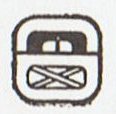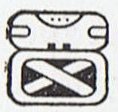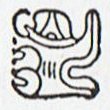4. Vindemeatrix (ε Virginis) is exactly at the 13h line, rising 8 days before Heze:
52 * 3 = 156 = 12 * 13 (= 104 * 150%) and the line of 13h could allude to the fate of Kuukuu:
182 + 26 = 208 (at the end of Ringiringi) is 10 more than 198 (at Vindemiatrix) and October 15 has an ariki glyph:
The day number is 144 + 144 = 288. Vindemiatrix is the right hand of Virgo and thus represents her 'life' (active) side, whereas Spica is at her left hand and represents her 'dormant' side. 52 * 9 (at Spica) = 468 = 13 * 36 = 18 * 26. Allen: "ε, 3.3, bright yellow, is the Vindemiatrix of the Alfonsine Tables, whence it has descended into modern tables; but in Latin days it was Vindemiator with Columella, which is found as late as Flamsteed; Vindemitor, with Ovid and Pliny; and Provindemiator and Provindemia major, with Vitruvius; all signifying the 'Grape-gatherer', from its rising in the morning just before the time of the vintage. These titles were translations of the Προτρυγετήρ, Προτρυγετήσ, Προτρύγετοσ, and Тρυγετήρ, used by Ptolemy, Plutarch, and other Greek authors, the first of these words appearing in the Phainomena, and rendered the 'Fruit-plucking Herald'; but it is in a line of the poem considered doubtful; Riccioli had Protrigetrix. This profusion of titles from the earliest times indicates the singular interest with which this now inconspicious star was regarded in classical times. The Century Cyclopedia has the following note on it: At the time when the zodiac seems to have been formed (2100 B.C.) this star would first be seen at Babylon before sunrise about August 20, or, since there is some evidence that it was then brighter than it is now, perhaps a week earlier. This would seem too late for the vintage, so that perhaps this tradition is older than the zodiac." I guess the 'fruit' (hua) could symbolize the new 'year' born beyond summer solstice. Virgo was divided into two parts, Furrow and Frond, and Furrow could represent 'the old calabash'. Mercury is the planet which suits Virgo best, because also he has a double nature, both male and female. A male should be standing straight up while a woman should lie down. Virgo is lying down and therefore ought to be female. However, the houses of Sun represent his development stages and Virgo can therefore alternatively be considered as the body of the dead 'Ceasar' lying there on a stretcher with one hand touching ground (at Spica). Rainclouds were depicted like grapes in the Mayan calendar, in the months beyond summer solstice (perhaps at 8 Mol). This season has 4 * 20 = 80 days and 4 * (1 + 2 + 3) = 24 'grapes':
'Meat' (13 Mac), 'Skeleton' (14 Kankin), and 'Vulture' (15 Moan) follow, completing the 'summer year'. "The cultivation of the domesticated grape began 6,000–8,000 years ago in the Near East. The earliest archeological evidence for a dominant position of wine-making in human culture dates from 8,000 years ago in Georgia." (Wikipedia) The form of a grape is rounded, like a drop. Gravitation (a word which easily associates to the heavy state of a gravid woman) will make rain fall and also fruits: ... When the man, Ulu, returned to his wife from his visit to the temple at Puueo, he said, 'I have heard the voice of the noble Mo'o, and he has told me that tonight, as soon as darkness draws over the sea and the fires of the volcano goddess, Pele, light the clouds over the crater of Mount Kilauea, the black cloth will cover my head. And when the breath has gone from my body and my spirit has departed to the realms of the dead, you are to bury my head carefully near our spring of running water. Plant my heart and entrails near the door of the house. My feet, legs, and arms, hide in the same manner. Then lie down upon the couch where the two of us have reposed so often, listen carefully throughout the night, and do not go forth before the sun has reddened the morning sky. If, in the silence of the night, you should hear noises as of falling leaves and flowers, and afterward as of heavy fruit dropping to the ground, you will know that my prayer has been granted: the life of our little boy will be saved.' And having said that, Ulu fell on his face and died ... |



















